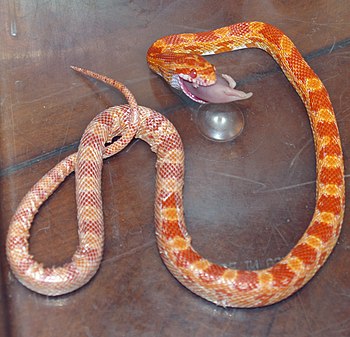I get a lot of questions about owning a Corn snake so I decided to put together a list of Corn snake facts that you should know before you consider owning one.
 |
| Corn Snake devouring a dead mouse fetus. (Photo credit: Wikipedia) |
1. TIME
There are a few on this list that can be considered "number one", however I feel this is probably the one most people tend to over look. While the maintenance for a snake isn't nearly as much as a dog, it's just as important. Like any pet, it's going to require feeding, handling, cleaning up after, etc. Remember that the life span of a healthy Corn snake is between 10 to 20 years.
2. PET SITTER
One of the most important things to plan for is finding someone responsible to care for your Corn snake whenever you must go out of town for any reason such as vacation or a business trip. Not only should they be responsible, they need to also not be afraid of snakes. You'll come to find that it isn't quite as easy as finding a pet sitter for a dog or cat. This brings me to the next thing on this list
3. MICE
Your snake will feed on either frozen or live mice. If the thought of handling this part of the responsibility makes you uncomfortable, this consideration should be very high on your list. Another thing to consider is that you will need to have a place to store the mice. Also, this will be another requirement for the person you select to watch your snake when you are out of town.
4. MONEY
Remember that your snake will need housing, a heating source, substrate, hides, and food. While baby Corn snakes can be kept in small containers, such as a shoe box; they will soon out grow it and will need to be moved to a bigger tank.
5. WHERE TO BUY?
I would suggest purchasing a corn snake from a local breeder, or from a local reptile expo. These shows are held annually in various cities across the country. If attending one of these shows isn't possible then my next suggestion would be to purchase it from a reputable website. Be sure to do a thorough research on Google for customer reviews and ratings. I would avoid purchasing one from a local pet store if possible but if you have no other choice, some things to look out for include: Is the store clean? Do the employees appear to be good with snakes and knowledgeable?
By asking a few basic questions, you'll know if they have any knowledge at all. Some questions you can ask include: What do you recommend for tank size? How often should I feed it? What is the idea temperature for my Corn snake? What should I do if it won't eat? If they can answer these types of questions then it's time to move onto the snake. Be sure to check the snake thoroughly. It should be alert and responsive. It should also be free of any scars or parasites. The body weight should be appropriate for its size, not scrawny and weak. It should also have good muscle tone.
[ Article Source: EzineArticles |







